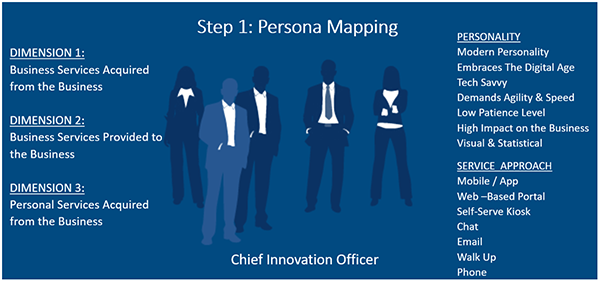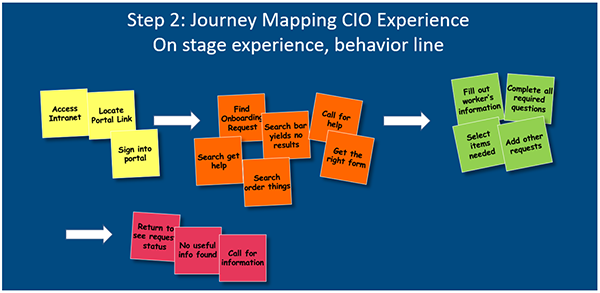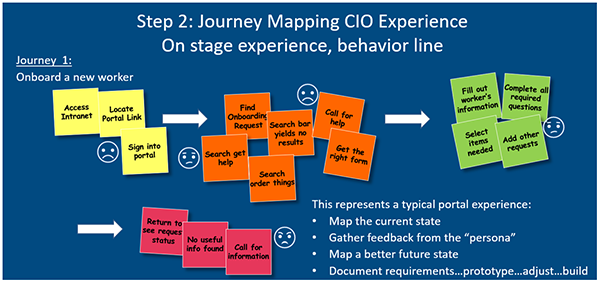Date Published July 3, 2018 - Last Updated December 13, 2018
The game has changed for technical organizations introducing self-service or a service portal to their customers. Instead of the days when people would either accept self-service environments as designed or call for support, today’s portal technology has advanced to be as capable as any mobile app or website. This, combined with the average user’s experience in the mobile app world, has created an environment where our customers are no longer willing to adopt a poorly designed service portal. Let’s look at what’s possible in building an excellent user experience.
Join Phyllis at Service Management World to get your service management content in person!
Join us!
Transform Technical Thinking to DX/UX Thinking
IT professionals are very different from marketing experts and graphics designers, but now we need to create a portal using the techniques they would use. Simple, right? Not really.
Many service management professionals struggle with designing a service portal from the customer’s standpoint. Organizations can see the result when they have trouble getting end users to use the portal.
Many service management professionals struggle with designing a service portal from the customer’s standpoint.

Consumers will sometimes shun an IT portal for a few key reasons:
-
They can’t find what they need when they search. The language used by IT is different, using technical terms rather than terms for which the customers would search. The result is lack of ability to find a specific request type by searching for it.
-
They can’t find what they need by browsing. IT often establishes a catalog taxonomy based on the way they think of services or the way they are organized, making it difficult for customers to browse the catalog’s categories to find what they need.
-
The forms are too complex. When they find what they need, customers either abandon them or don’t even try to complete them.
-
They are put off by the portal design and usability. Customers take one look at the portal and decide it’s a mess or looks like something from the mainframe era, or there are so many errors when they try to submit a request they assume they’ll never get what they need.
Customers are often right about their assessments. Keep in mind that that the people designing the items are typically technicians and think from the fulfiller’s point of view. While many requests can be fulfilled without ever calling the customer, highly technical services like setting up telecom hunt groups or advanced needs like large departmental moves will often need a consult no matter how many questions are asked. In these cases, asking a lot of highly technical or detail-oriented questions makes it difficult for the customer to complete the request and impacts their opinion of the portal. In general, it’s important for the portal to be easy to use.
Digital experience (DX) is a good catch term to describe the customer’s experience when they interact with your organization through any form of digital technology. It can include your digital branding, the breadth of the services you offer digitally, and your competence in supporting them.
Similar to DX, UX covers the user experience when using your digital services. Taken from the point of view of the service portal, it’s really about your design and the experience the of the user when they attempt to use your portal. If it takes 20 minutes to find and complete a request form, adoption is going to be slow or difficult. Think of a time when you ordered something online and couldn’t figure out how to take the next step, commit the cart, or put something in it. You knew there should be a button to do so but couldn’t find it. This is all part of UX design.
In situations where IT doesn’t have digital or user experience designers working in-house, the marketing and communications organizations are often very willing to help with branding and design and to be the voice of the customer during design sessions. I’ll explore two steps that the DX industry uses to help design web or application interfaces: persona mapping and journey mapping.
Understand Your Personas and their Journey

A persona can be described as a role someone plays in the organization, the services they consume and/or provide, their on-line personality, and even their likes and fears. Common to the DX or UX approach, key personas are defined; think of them as key stakeholders who will use the end product or in this case, the service portal. A persona can represent a single person in a role or a group of people, all with the same role.
When mapping out a persona, create a template containing the following key data points (also shown in the graphic):
- Their name(s) and position or role
- Services they provide to/within the organization
- Services they consume (both business and personal, such as Benefits services)
- Their personality type
- Their engagement/communication style or service approach
Collecting this information will provide key information about how they can be engaged, helping to document those channels the various persona will adopt. Not everyone will accept use of a portal, although the percentage is growing along with phone app and internet use. This is an important aspect of portal design, as it may be important to find reasons to draw people away from their chosen journey.
For example, you can use long wait times and announcements to suggest people check the portal for outage information and to log non-critical issues or requests. Use an e-mail marketing campaign to educate them on why the portal is better than sending an email. Understanding their preferences assists in the development of appropriate marketing campaigns.
Information about your personas and their journeys (use cases in more technical terms) is generally collected via interviews. When dealing with a single person in a role, a personal interview is easy. But a strategy is needed for collecting this information from a group of people who make up a single type of persona. In this case, focus groups can provide an effective way of doing so. The focus group should gather no more than 10–12 people, and in this case, the interview is conducted as a discussion with a group of participants.
When working with a focus group, it’s important to remember that not everyone will have the same personality or service approach. It is important to collect any/all diverse service approaches and personality types, even if it means documenting three or four personas for a single group of people. Ultimately the design needs to embrace all of them.
In addition to understanding who will be using the portal and their service approach, it’s important to include selection of a few use cases during the interview process. It’s a good idea to prepare a journey map for general use of the portal. For example, when would they use it, why, and how, but also to identify specific uses they would make of it, such as onboarding a new employee or arranging to have people moved within their department or even something as simple as requesting a computer and software.
The next step, creating a journey map of the experience and their impressions of the current state, will leverage these use cases.

Journey mapping is a rather simple process and uses a Kanban-style approach to mapping the steps a persona would take when interacting with the portal. Typically, both an “on-stage” and “backstage” experience are mapped: demonstrating the end user’s journey (on-stage) and the fulfillers’ journey (backstage).
Once you have diagrammed the experience with the persona, the next step is to add their emotions to the process. Adding emotions to the experience shown previously, might look like this:

The experience emotions add the factor needed to improve or transform their experience. In the example shown, an existing portal is being improved. You can easily see that there are several improvements that can be made to drive adoption:
- Add single-sign on to the portal.
- Improve searching and the taxonomy. If onboarding a new team member is frequent, consider adding it to the landing page.
- It also looks like there are opportunities to streamline the actual request itself, to help get everything into one bundle (or ensuring that if they tend to request the same things each time they onboard someone that the design enables them to save the selections as a bundle, for future use).
- Finally, it’s key to the CIO’s experience that they expect to see updates and progress throughout the process. To accomplish this may require cultural changes on the part of the fulfillers to ensure they are keeping the ticket updated.
Journey mapping the backstage experience might show similar improvement opportunities. For one thing, if fulfillers are not updating the ticket, downstream fulfillers are also likely to be impacted. For another, repeated calls to the service desk for updates will be frustrating for the consumer and thus for the agents taking the calls, particularly if they have no update to provide.
The goal of the journey mapping process is to communicate heavily with the people who will be using the portal, both consumers and fulfillers, in order to define design opportunities that will provide a great end-to-end experience. It doesn’t matter if an expert in persona and journey mapping does the work or if it’s done by someone new to the process as the goal is to gain an understanding of the users’ needs. As long as the process can be used to gain this, the goal will still be achieved.
Benefits of the DX/UX Approach
At the end of the day, DX/UX is not a huge change to good practices for designing tools people will use. Persona and journey mapping simply formalize the processes used to do so. It makes requirements definition and technical workflow design easier for end users to understand by taking away the technical aspects of such discussions. In simple terms, it enables IT to speak with consumers in language they understand.
There is a lesson to be learned, however. Internet and phone use has driven a level of expectation that IT needs to achieve as well. IT now competes with innovative solution providers moving into our space, and now we need to be as innovative as they are. The focus on the digital experience is one way this happens.
This application of these DX/UX practices is beneficial throughout IT and can/should be applied to all services provided. It will keep IT innovating and building solutions end users will love.
Phyllis Drucker is an ITIL® certified consultant and information leader at Linium, a Ness Digital Engineering Company. Phyllis has more than 20 years of experience in the disciplines and frameworks of IT service management, as both a practitioner and consultant. She has served HDI since 1997 and itSMF USA since 2004 in a variety of capacities including speaker, writer, local group leader, board member, and operations director. Since 1997, Phyllis has helped to advance the profession of ITSM leaders and practitioners worldwide by providing her experience and insight on a wide variety of ITSM topics through presentations, whitepapers, and articles and now her new book on the service request catalog, Online Service Management: Creating a Successful Service Request Catalogue (International Best Practice). Follow Phyllis on Twitter @msitsm.